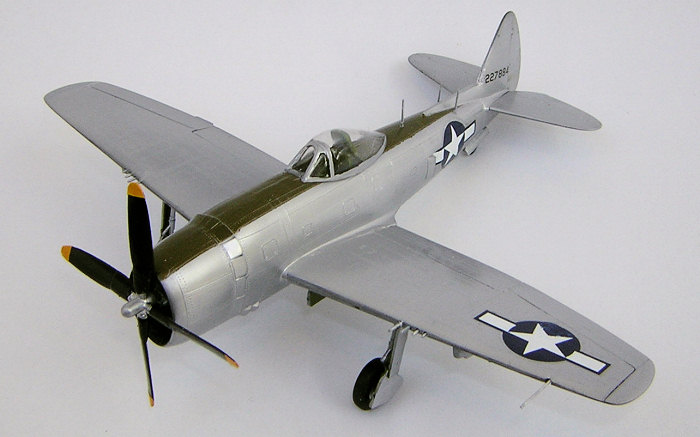
Heller 1/72 P-47N Thunderbolt
| KIT #: | 084 |
| PRICE: | $ |
| DECALS: | One option |
| REVIEWER: | Joel Hamm |
| NOTES: | Pass on this one. |

| HISTORY |
Thunderjugs have never been my thing. Neither do I often multitask two projects. But while toiling on a labor intensive resin kit I tried for some comic relief with a quickneasy build, which as usual wasn’t. A dive in the stash brought up this Heller kit that had been bought back in the days when the only other bubbletops available were a vacuous 1st generation Hasegawa, and the totally deformed pre-cambrian Revel from their 49 center series. This one bested neither.
The N model was the last production variant of the near 16,000 P47’s produced. Intended for the Pacific campaign, it carried more fuel, more external stores, and a larger wing and engine to carry both. Externally, it’s chiefly recognizable by the truncated dorsal fin, the triplicate stub antennae surrounding it, and the fixed bomb and rocket pylons under the squared off wings.
| THE KIT |
 A first look at the
box contents is encouraging, as long as the kit’s vintage is kept in mind. Big
parts are cleanly molded, with petite rivets and understated raised panel lines.
A closer look and dry-fit session, however, reveal just how undiscriminating we
were in those days. Small parts are simplistic, the canopy is thick (but clear),
and semi-major boo-boos infect the basic shape and details. At peril of being
perceived as a modeling malcontent I’ll list some of these discrepancies,
emphasizing that they evidence themselves through just a casual comparison with
photos, rather than through any imagined expertise on P-47’s.
A first look at the
box contents is encouraging, as long as the kit’s vintage is kept in mind. Big
parts are cleanly molded, with petite rivets and understated raised panel lines.
A closer look and dry-fit session, however, reveal just how undiscriminating we
were in those days. Small parts are simplistic, the canopy is thick (but clear),
and semi-major boo-boos infect the basic shape and details. At peril of being
perceived as a modeling malcontent I’ll list some of these discrepancies,
emphasizing that they evidence themselves through just a casual comparison with
photos, rather than through any imagined expertise on P-47’s.
The windscreen framing and profile step to the bubble are overdone (there should be none of the latter). The canopy base is formed to a flat plane, rather than the sinuous recurve that allowed the real thing to snuggle and slide against the tapered deck. The deck is squooshed down flat so there’s no fix for that, other than re-contouring both parts. The wing tips appear not square enough. They can be filed. The dorsal fin is a bit high and improperly angled. Ditto. The intercooler doors are molded as outward swung single panels, but photos show the openings were formed by two inwardly opening parts. The fix for that is filling and filing them closed. The engine cowl lip is short-shot; curving insufficiently inward and leaving a cookie-cutter knife-edge. The fix for that is discarding the kit. I continued struggling with it solely to use as a test vehicle for Floquil’s silver paints, which several MM’ers had correctly tagged as realistic, easily applied, tape resistant alternatives to exotic metalizer concoctions
| CONSTRUCTION |
The lowly engine can be
heaped high with pejoratives, but it’s sufficient to simply say that it’s
unusable. No, that’s not quite right. I found a perfect use for it by turning it
backwards and using it as a bulkhead on which to hang an acceptable alternate
from the spares box. That replacement lacked the twin magnetos on its schnoz, so
I spent an entire afternoon (while paint dried on the
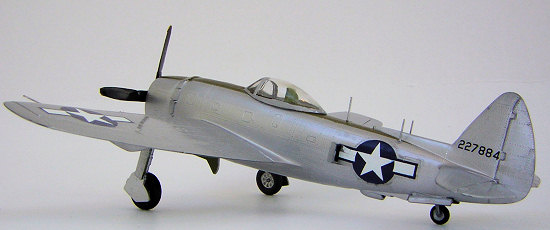 resin kit and a cold rain
drenched any dreams of tilling the garden) excising the mags from the Heller
nosecone and transplanting them to the new radial. There’s a word for such
idiocy: Horbgorbling – wasting inordinate time and energy on unproductive
projects, often in avoidance of attendance to more pressing but distasteful
tasks; eg. organizing coffee cans full of rusty nuts and bolts in the shop,
rather than fix the leaky toilet tank. There are lots of such words for lots of
such idiocies and idiots. A verbolater [word lover] might note that
overindulgence (or merely indulgence) in modeling can lead to a case of
cagamosis [marital strife], unless one is lucky enough to have entered into a
state of nomogamosis [well-matched marriage] with a like minded modeler; though
too many of us exist under conditions of uxorodespotism [deference to SWMBO].
You may have guessed that I got a nifty word book for my birthday.
resin kit and a cold rain
drenched any dreams of tilling the garden) excising the mags from the Heller
nosecone and transplanting them to the new radial. There’s a word for such
idiocy: Horbgorbling – wasting inordinate time and energy on unproductive
projects, often in avoidance of attendance to more pressing but distasteful
tasks; eg. organizing coffee cans full of rusty nuts and bolts in the shop,
rather than fix the leaky toilet tank. There are lots of such words for lots of
such idiocies and idiots. A verbolater [word lover] might note that
overindulgence (or merely indulgence) in modeling can lead to a case of
cagamosis [marital strife], unless one is lucky enough to have entered into a
state of nomogamosis [well-matched marriage] with a like minded modeler; though
too many of us exist under conditions of uxorodespotism [deference to SWMBO].
You may have guessed that I got a nifty word book for my birthday.
But I digress, and happily so, because recalling the difficulties and disappointments of this kit temps a detour to the shop for a session of sorting coffee cans of rusty nuts and bolts. Nevertheless, if one aspires to becoming a world reknown model airplane kit reviewer – “It can’t be helped. It must be done. So down with your britches, and out with your bum.” Where was I? Oh yes, the replacement engine with transplanted magneto humps improved the resemblance to a real Thunderbolt, but the build couldn’t avoid resulting in a sow’s arse. On the plus side, all parts fit together easily without need of seam filling.
| COLORS & MARKINGS |
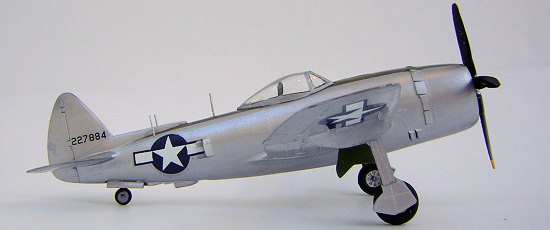 As I said, the kit really just
served as a victim upon which to experiment with Floquil metallic enamels, which
airbrushed easily with the standard dilution of 25% or so paint thinner and
15+/- lbs air pressure with the needle cranked down to a fine mist. . Bright
Silver and Platinum Mist were the only shades stocked by the local hobby shop.
I couldn’t see any difference between them in the bottles, nor could I on
separately sprayed panels. For masking I sadistically used high tack 3M “720
Tape” a super stretchy PVC automotive masking tape. When it was pulled up a
barely visible sheen of silver flakes stuck to the glue, but the painted surface
showed no marring at all. Will be using this Floquil stuff as my NMF weapon of
choice.
As I said, the kit really just
served as a victim upon which to experiment with Floquil metallic enamels, which
airbrushed easily with the standard dilution of 25% or so paint thinner and
15+/- lbs air pressure with the needle cranked down to a fine mist. . Bright
Silver and Platinum Mist were the only shades stocked by the local hobby shop.
I couldn’t see any difference between them in the bottles, nor could I on
separately sprayed panels. For masking I sadistically used high tack 3M “720
Tape” a super stretchy PVC automotive masking tape. When it was pulled up a
barely visible sheen of silver flakes stuck to the glue, but the painted surface
showed no marring at all. Will be using this Floquil stuff as my NMF weapon of
choice.
Decals.
Nothing good can be said about them. They were thick, inaccurate, wouldn’t come
off their paper, wouldn’t go on the plastic. Threw them away. I found a pic of
minimally marked N’s and scrounged up some Nat insignia and a pair of bogus tail
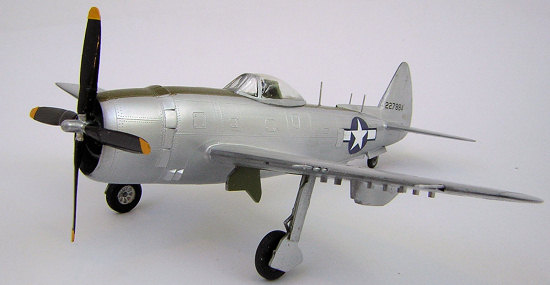 codes. The fuselage insignia
are intentionally improperly placed a smidgen too low, because a first set was
ruined, and a good deal of time wasted, trying to cut and fit the forward “bar”
into the improperly open-molded intercooler door. It’s a minor of many
inaccuracies.
codes. The fuselage insignia
are intentionally improperly placed a smidgen too low, because a first set was
ruined, and a good deal of time wasted, trying to cut and fit the forward “bar”
into the improperly open-molded intercooler door. It’s a minor of many
inaccuracies.
Part of the Floquil experimentation involved finding an overcoat that would not dampen the NMF sheen. MM’ers may recall a forum thread I put out a while ago seeking recommendations on a Future retarder. I found one at the local Michaels (or maybe it was Ben Franklins) artsy-craftsy sore in the form of Grumbacher’s acrylic paint flow improver ($7 / 4oz). It’s not really a retarder, just a surfactant; but it allows application of a very thin coat without graininess. About 10 drops to ¼ oz of Future. Interestingly, trying to apply a heavier glass coat with the stuff results in precisely the graininess the avoidance of which was sought. Go figgur.
| FINAL CONSTRUCTION |
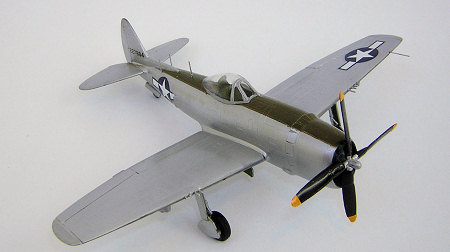 The only noteworthy entry in this department is mention that the main gear
wheels are in the same accuracy league as the engine. I found an acceptable
pair of spoked ones in the junk box and glommed them onto the simplified,
too-long legs flanked between slab doors devoid of interior detail. The
asymmetrical prop looked pretty good and did a fair job of obscuring the
cookie-cutter cowl opening; but I wouldn’t stake my stock market winnings on a
bet that this is the correct screw for this variant.
The only noteworthy entry in this department is mention that the main gear
wheels are in the same accuracy league as the engine. I found an acceptable
pair of spoked ones in the junk box and glommed them onto the simplified,
too-long legs flanked between slab doors devoid of interior detail. The
asymmetrical prop looked pretty good and did a fair job of obscuring the
cookie-cutter cowl opening; but I wouldn’t stake my stock market winnings on a
bet that this is the correct screw for this variant.
| CONCLUSIONS |
With parts that fit together sans cussin’r’fussin’, with silver plastic that can pass unpainted, and with a price of only $2-$3 at swap meets, Heller’s 47-N can make a good single afternoon project for a kid; but with so many T-bolts on the block in any scale and variant, it’s a poor starter place for an accurate Jug.
September 2007
If you would like your product reviewed fairly and fairly quickly, please contact the editor or see other details in the Note to Contributors.